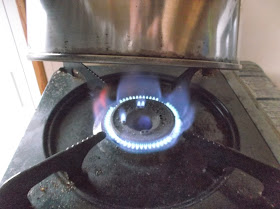First of all, here is an overview of my three coffee roasters.
まずは、私が持っている3種類のコーヒー焙煎機の概説です。
1. Milk can roaster
Bottom diameter: 13 cm
Height: 18 cm
Recommended amount of coffee beans to roast at a time/maximum capacity: 150/200 g
Features: With its appropriate number of holes with an appropriate size on the bottom, this roaster is designed so that first crack occurs in 12-14 minutes after the start of roasting when used with a 2,500 kcal/h portable gas burner (set to high right from the beginning).
Because of its great height, exhaust air control is "automatic".
Suitable for beginners.
1. ミルク缶焙煎機
底面の直径:13 cm
高さ:18 cm
一度に焙煎するコーヒー豆の量、推奨/最大:150/200 g
特徴:底面に適切なサイズの穴が適切な数だけ開いており、2,500 kcal/hのカセットコンロ(最初から「強」にセット)を使えば、焙煎後12~14分後に1はぜが起きるように設計されている。
高さがあるため、排気コントロールは「自動」。
初心者向き。
Six, twelve, and twelve holes on the circumferences of 2, 4, 5.5 cm radius circles.
The diameter of each hold is about 3 mm.
半径2、4、5.5 cmの円周上に穴が6、12、12個。
それぞれの穴の直径は約3 mm。
One big drawback is that it tends to escape the flame when you shake it up and down.
大きな欠点の一つは、上下に振る時に炎が逃げる傾向にあることです。
2. Kettle roaster
Bottom diameter: 19.5 cm
Height: 9 cm
Recommended amount of coffee beans to roast at a time/maximum capacity: 200/250 g
Features: Because of its shape (narrow at top), keeps the heat in, so that it tends to roast coffee in a short period of time.
(First crack occurs 9 minutes after the start of roasting no matter how I try to control the heat.)
No need to place the lid.
Should be ideal for those who prefer dark roast coffee.
2. やかん焙煎機
底面の直径:19.5 cm
高さ:9 cm
一度に焙煎するコーヒー豆の量、推奨/最大:200/250 g
特徴:その形状(上が狭い)のため、熱がこもり、焙煎が短時間になる傾向。
(どんなに火力を調整しても、焙煎開始9分後に1はぜが起きる。)
蓋をする必要は、なし。
深煎りのコーヒーが好きな人には理想的でしょう。
8, 16, 16, and 16 holes on the circumferences of 2, 4, 6, and 8 cm radius circles
半径2、4、6、8 cmの円周上に穴が8、16、16、16個
The bottom covers the entire flame range.
底面は炎の範囲全体をカバーしています。
3. Shallow pot roaster
Bottom diameter: 24.5 cm
Height: 7 cm
Recommended amount of coffee beans to roast at a time/maximum capacity: 300/400 g
Features: For the initial ten minutes of roasting, you MUST cover the top with a lid or something similar (I use aluminum foil) to keep the humidity inside the pot high.
Unlike the two roasters above, you will shake it back and forth and sideways and move it in a circular motion to ensure even roasting.
3. 浅い鍋焙煎機
底面の直径:24.5 cm
高さ:7 cm
一度に焙煎するコーヒー豆の量、推奨/最大: 300/400 g
特徴: 焙煎の開始から最初の10分は、蓋など(私はアルミホイルを使ってます)で上部を覆い、鍋の内部の湿度を高く保つ必要があります。
上記の2つの焙煎機とは異なり、むらなく焙煎するには、前後左右に振ったり、円を描くように動かすことになります。
8, 16, 16, 16, and 16 holes on the circumferences of 2, 4, 6, 8, 10 cm radius circles
半径2、4、6、8、10 cmの円周上に穴が8、16、16、16、16個
The bottom area is considerably larger than the flame range. That's why you have to shake the pot back and forth and sideways and move it in a circular motion.
底面の面積は、炎の範囲よりかなり大きいです。そのため、鍋を前後左右に振ったり、円を描くように動かす必要があります。
***
Now, based on the above description, you should be able to decide which type of coffee roaster you want to make. I personally recommend the third one because it can roast 300-400 g of coffee beans properly.
さて、これまでの説明で、どの種類のコーヒー焙煎機を作りたいか決められると思います。個人的には、3番目のがコーヒー豆を300~400 g焙煎できるので、お薦めします。
Lastly, from my experience, I wouldn't recommend a skillet, cast iron pot, or other heavy pot. For such pots, you can't make holes on the bottom with nails, you can't control the heat at will because of their high heat capacity, and you can't shake a heavy pot continuously for 14-16 minutes.
最後に、自分自身の経験から、フライパン、鉄鍋など重い鍋は薦めません。そういう鍋だと、釘で底に穴を開けられないし、熱容量が高いので、火力を自由に調節できないし、14~16分も振り続けられないからです。
To be continued. The next post will be a summary of direct flame roasting.
続く。次の記事は直火焙煎のまとめです。





































